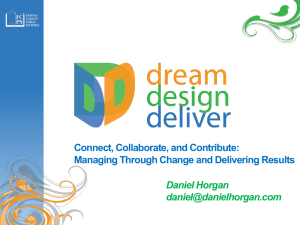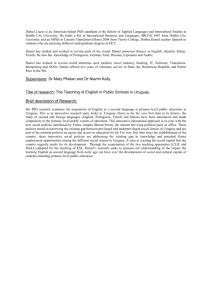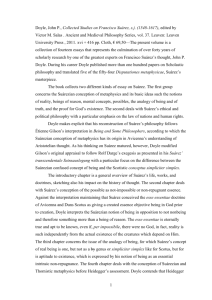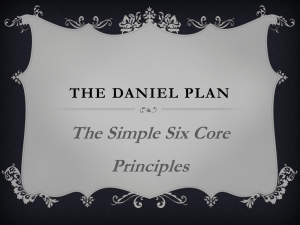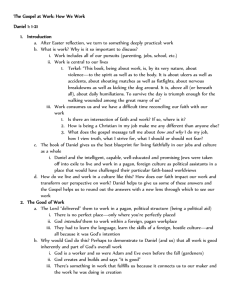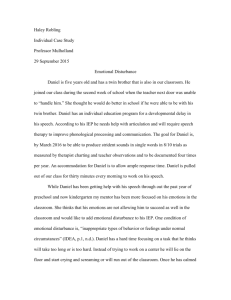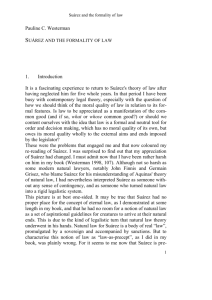COURSE PROGRAM COMMUNICATION SKILLS I Period 2013
advertisement
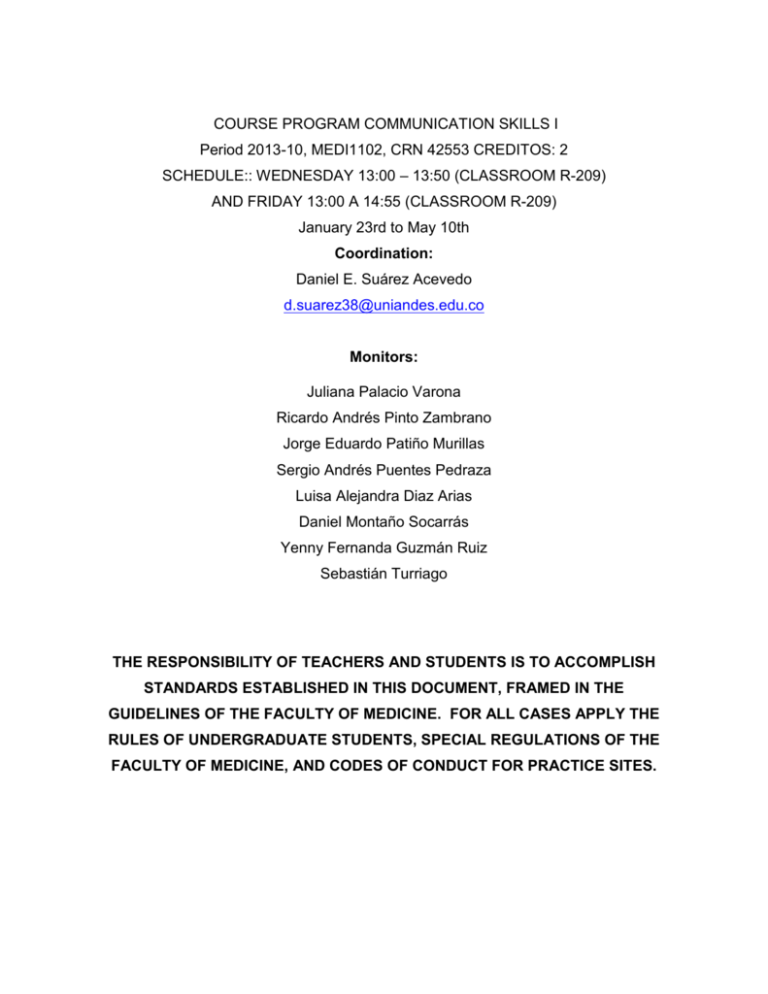
COURSE PROGRAM COMMUNICATION SKILLS I Period 2013-10, MEDI1102, CRN 42553 CREDITOS: 2 SCHEDULE:: WEDNESDAY 13:00 – 13:50 (CLASSROOM R-209) AND FRIDAY 13:00 A 14:55 (CLASSROOM R-209) January 23rd to May 10th Coordination: Daniel E. Suárez Acevedo d.suarez38@uniandes.edu.co Monitors: Juliana Palacio Varona Ricardo Andrés Pinto Zambrano Jorge Eduardo Patiño Murillas Sergio Andrés Puentes Pedraza Luisa Alejandra Diaz Arias Daniel Montaño Socarrás Yenny Fernanda Guzmán Ruiz Sebastián Turriago THE RESPONSIBILITY OF TEACHERS AND STUDENTS IS TO ACCOMPLISH STANDARDS ESTABLISHED IN THIS DOCUMENT, FRAMED IN THE GUIDELINES OF THE FACULTY OF MEDICINE. FOR ALL CASES APPLY THE RULES OF UNDERGRADUATE STUDENTS, SPECIAL REGULATIONS OF THE FACULTY OF MEDICINE, AND CODES OF CONDUCT FOR PRACTICE SITES. I. Course Description This course aims to give the student the second semester of Medicine theoretical. - Basic practical elements of communication, which will allow them to delve into the different aspects involved in human communication, as well as in contents and nuances of the doctor-patient relationship, to achieve them, the development of basic skills in medical interview through practice with standardized patients. Throughout this course students should acquire the knowledge; skills and attitudes that enable them primordial to understand and reflect on the physician-patient communication and the different aspects involved in this relationship. Be essential to facilitate the processes of communication with patients and their families as well as with other colleagues and health professionals, which are essential in the development of the profession of medicine components. II. Competencies to achieve by the end of the course: At the end of the course the student: Main competence: Has skills for an interview approach to health in simulated patients, at different times of their individual life cycle and within the context of the doctor-patient relationship Specific Competences: 1. Know basic aspects of human communication theories and their application in the doctor-patient relationship. 2. Knows and it has skills related to communication strategies as empathy, listening, managing analog and digital language and various techniques used in the interview. 3. Knows, understands and uses the essential elements of the doctor-patient relationship 4. Recognizes and takes into account social and cultural aspects in the interview approach to the health of individuals 5. Knowledge and application of the bio-psychosocial model interviews, focusing on the person and their family 6. Know, understand and apply the basic structure of interview approach to the health of people 7. Recognize barriers and difficult contexts in communication and applies some strategies for handling these situations 8. Acknowledge, understands and begins to assume professional values. III. Methodology The course will run through masterful interactive methodologies, workshops and sessions "standardized patient"; it will face activities and aimed to promote independent learning skills and consolidate the proposed competences The description of the teaching methods used to develop course contents and achieve the proposed objectives Interactive Magistral: It is expected that after the conference, an individual reading, students, in small groups discuss methods applied to analyze, synthesize and evaluate the acquired knowledge. Workorkshop: Teachers offer concrete experiences designed by them to Consolidate the knowledge studied, so that students through observation and experimentation in natural environments and / or simulated apprenticeship use these skills address to clinical situations. To achieve the objectives of the workshops is essential for students to read and review the text before and the resources of the session, read the observation guide, instructions, and questions and from there made his observation and / or active intervention. After the experience it is expected that each one make notes or results obtained during the experience, and a session report. These sessions will be fed back by the teacher. Standardized Patient: Methodology through which students in the exercise of its medical rol / carry out several interview sessions in the context of the doctor-patient relationship, with a group of standardized patients (actors). Borrell y Cols define the standardized patient as healthy or sick person that simulates a health demand, understanding standardized that must adjust their communication pattern to very strict rules and always has a predetermined semi logical data, and indeed its aspect itself and its physical features have been selected to adjust requirements of the script. The standardized patient should always act the same way, without improvising, regardless of the professional who is in front. Although, adapts its responses to the professional, it is predetermined the amount of information and how it is given predetermined. V. Professors: Elena María Trujillo Maza, MD. Specialist in Medicine in Family etrujill@uniandes.edu.co Germán Casas Nieto, MD. Specialist Child and Adolescent Psychiatrist gcasas@uniandes.edu.co Alcides Caicedo Concha, MD. Pediatrician Efebólogo alccaice@uniandes.edu.co Daniel E. Suárez Acevedo, MD. Specialist in Psychiatry and Epidemiology Magister in Bioética d.suarez38@uniandes.edu.co V. Course Schedule and List of Topics: Date Contents and activities Wednesday Introduction course Teachers and Monitors General map of the course Evaluation forms January 23rd (1 hr) Friday Theories in human January 25th communication: SEMIOTICA Axioms of WASLAWICK Methodology Professor and audiovisual equipment Interactive Magistral Daniel Suárez Video Beam Monitores Interactive Magistral Daniel Suárez Readings None Theory in Communication Video Beam (2 Hrs) (2 hrs) Waslawick Monitor SEMIOTICA Wednesday Theories in human Communication Interactive Magistral Daniel Suárez Theories in human Communication January30th SEMIOTICA WASLAWICK Video Beam (1 hr) Waslawick ( 1 hr) Workshop on Film WIT Monitor WORK 1 Friday February 1st COMMUNICATION WORKSHOP WORKSHOP Daniel Suárez Theory in the Communication Elena Trujillo Monitors actors (2 hrs) Waslawick Interactive Magistral E. Trujillo Model BioPsycho-social Video Beam Monitor -Essential elements in Communication (Recognizing the analogical language) (2hrs) Wednesday February 6th Care Attention Centered in the person Model and Bio-Psycho-Social (1 hr) Friday Projection video Doctor -Patient Relationship: General Dimensions Doctor Patient Relationship Masterful Interactive Kalamazoo consense Daniel Suárez (2hrs) Texts over RMP february 8th Video Beam (2 hrs) Projection video Wednesday asic Structure of the clinical interview model HC Initial Visual display of student evaluation form in the role of doctor Febrero 13th (1 hr) Friday Technical aspects of the interview: type of questions, strategies to obtain information, February15th introduction student evaluation (2hrs) form in the role of doctor Monitor El Doctor Video Beam, sound and video Daniel Suárez Workshop (1 hr) Interactive Magistral and Workshop Video Beam See movie Monitor Daniel Suárez Guide to make clinical history and instrument HC student format assessment in a rol as a doctor - Is communication a skill? (2 hours) - What else? Monitors - Rakel, Text Book Family Medicine Cap 20 Interviewing Techniques Wednesday 20-feb (1 hr) RAPPORT Interactive Magistral Daniel Suárez Video Beam (1 hrs) Monitor ve Rakel, Text Book Family Medicine Chap 18 Establishing Rapport Friday WORKSHOP: DISPLAY MEDIA INTERVIEW AND TRIOS Video Projection Elena Trujillo 22-feb Using formats for HC and assess the student in the role of doctor Trios communication Daniel Suárez Interviews with teachers Germán Casas (2 hrs) Wednesday ETHNICITY AND CULTURE 27-feb WORK 2 (1 hr) Friday PERSONAL AND FAMILY LIFE CYCLE SEXUALITY Alcides Caicedo Monitors (2 Hrs) Elena Trujillo Video Beam Interactive Magistral display of videos and discussion (1hr) None “Ethnicity Issues in health care” (Fotocopies) Monitores Elena Chapters 4 and Trujillo 5 Sexuality Elvia Vargas Video Beam 01-Mar 08-mar Parcial 1 13-mar (1 hr) Daniel Suárez Medical interview and application of the basic structure of the medical history Practice sessions with actors standardized patient Elena Trujillo SESSION 1 PART STANDARIZED Video camera Daniel Suárez no audiovisual Germán Casas (2 hrs) Wednesday -The same but different: clinician– patient communication Monitores with gay and lesbian patients (2 hrs) Miércoles 06-mar (1 hr) Viernes (2hrs) Interview to the adult and mature Interactive Magistral Video Beam None Alcides Caicedo Monitores (2hrs) Elena "Process to Trujillo become ill and patient" (1 hr) Friday Interview to the adult and mature Practice sessions with standardized patient Elena Trujillo 15-mar SESION 2 STANDARIZED PATIENT Actors Daniel Suárez No audiovisuals Germán Casas (2hrs) Miércoles (1 hr) Friday 22-mar (2 hrs) Alcides Caicedo Monitores (2hrs) Elena Promoting Trujillo communication in older adults (1 hr) Interview with elderly Interactive Magistral Video Beam Interview with elderly Practice sessions with standardized patient Elena Trujillo SESSION 3 STANDARIZED PATIENT Actors Daniel Suárez No audiovisuals Germán Casas 20-mar None Alcides Caicedo Monitores None Wednesday Type of interviews to child 03-abr Masterful Interactive (2hrs) Daniel Suárez Video Beam (1 hr) (1 hr) Communication in children Friday Child Interview Practice sessions with standardized patient Elena Trujillo 5 abril (2 hrs) SESSION 4 STANDARIZED PATIENT Actors Daniel Suárez No audiovisuals Germán Casas Wednesday Interviewing with the family 10-abr Class of interviewing adolescents Interactive Magistral Video Beam (1 hr) Friday teen interview Practice sessions with standardized patient None Alcides Caicedo Monitores (2hrs) Daniel Interviewing the Suárez adolescent (1 hr) Elena Trujillo None 12-abr SESSION 5 STANDARIZED PATIENT (2 hrs) Wednesday The interview doctor - patient relationship 19-April The interview doctor - patient relationship SESSION 6 STANDARIZED PATIENT (2 hrs) Wednesday Daniel Suárez No audiovisuals Germán Casas Interactive Magistral Alcides Caicedo Monitores (2hrs) Daniel Suárez (1hr) Pendant Video Beam 17-abr (1 hr) Friday Actors The doctor-patient relationship and communication barriers Practice sessions with standardized patient Elena Trujillo Actors Daniel Suárez No audiovisuals Germán Casas Interactive Magistral Alcides Caicedo Monitors (2hrs) Elena María Trujillo(1 hr) None *CALMER Video Beam 24-April ( 1hr) Friday The doctor-patient relationship and communication barriers 26-April (2 hrs) SESSION 7 STANDARIZED PATIENT Practice sessions with standardized patient Elena Trujillo Actors Daniel Suárez Germán Casas No audiovisuals *How to manage a difficult patient Alcides Caicedo Monitores (2hrs) Wednesday 01-may (1 hr) Friday HOLIDAY COURSE EVALUATION 03-may (2 hrs) Wednesday 08-may (1 hr) Friday 10 May Elena Trujillo Daniel Suárez Students charged of questions Partial 2 Micros Room Daniel Suárez Monitores None Final - Exam standarized patient Recording Videos Actors Elena Trujillo None (5 hrs) (1:00pm -5:00pm) monitors Daniel Suárez 12 computers laptops Monitores Elena Trujillo Wednesday Feedback – Final Exam 4 computers Laptops 15-may 8:00 –12 m Edificio Q – 8 piso Daniel Suárez CP-116 Germán Casas Alcides Caicedo Feedback – Final Exam 4 computers laptops Elena Trujillo 8:00 – 12:00 pm Building Q – 8 piso Daniel Suárez CP- 116 Germán Casas Alcides Caicedo (5 hrs) Friday 17 may (4 hrs) None None VI. EVALUATION: During the course there are short tests and works in class to assess knowledge as well, as attitudes and skills observed and acquired by the student through their contributions and participation in the various course activities. Two tests were made and it will be graded the patient sessions standardized which will qualify the first two scores with a value of 15% and the second one 20% of the total course grade. Attitudes and skills during the interview were assessed using a scoring matrix; this is used by the patient (actor), by the teacher and the observer student or by it. Attendance: There will be an assistance control of the theoretical and practical sessions. If some type of evaluation is done in class, the student who does not attend without valid justification according to the regulations of the university, have a grade of 0 (zero). Failures to attend practice sessions involve the grade of zero for that session. The unexcused absence for more than 20% of the scheduled sessions of the course will get an automatic qualification in the subject of 1.5 Qualification Form: Achievement of the tests and shorter works: Participation in the standardized patient sessions 1: 15 % Participation in the standardized patient sessions 2: 20% Parcial ( Test) 1 14% Parcial ( Test) 2 10% Final Test Interview standardized patient 21% 20% F Dates limit to handle notes in: - Friday March 8th : First Test (parcial) (15%) Quizes and short Works until date (17%) Wednesday April 10th : First evaluation of Standardized patient (15 %) - Friday May 3rd : Second evaluation of Standardized patient (20%) Quizes Left (3%) - Wednesday May 15th : Second Test (parcial) (10%) - Tuesday May 21st : Final Exam Standardized patient (20 %) Definite (100%) If the student does not attend a scheduled presentation or feedback session of the final interview of a standardized patient assessment without just cause, will have a rating of 0. Important information to be taken into account in Presentation in the Writing and Oral Evaluation: You must be in time for the exam because the exam will begin at the scheduled time. No backpacks are allowed, textbooks, notes, beepers, briefcases, PDAs therefore prepared to leave them in the locker The use of hats with wings are no allowed during the exam (eg, baseball caps) Please leave all personal computers, cell phones at home or in the locker Do not hide your face during the examination with caps, hats, scarves or similar. If the student does not attend to a scheduled presentation without a justified cause the assessment will get a score of 0. Remember, the best way to prepare during the course, is carrying out the corresponding readings at the same time. PLEASE REFRAIN FROM HAZARDOUS TO YOUR SPACE AT THE UNIVERSITY. ANY STUDENT PF THE CAREER OF MEDICINE WHO KITE FRAUD OR COPY MAY BE PUNISHED WITH UP TO EXPULSION Table approximation of the final note Banner According to the Academic Council of the Faculty of Medicine (Act 14 of June 2005): From 0.00 1.76 2.26 3.00 3.26 3.76 4.26 4.76 To 1.75 2.25 2.99 3.25 3.75 4.25 4.75 5.0 Note 1.5 2.0 2.5 3.0 3.5 4.0 4.5 5.0 REMEMBER: To pass you must pass, a note of 2.99999 approaches 2.5. A note of 3.0 means that you know 60% of what a doctor should know General and still is allowed to proceed. Try to negotiate a note, indicating that the student tries harder for a minimum average more than to learn and be a responsible professional. VII. LEARNING IN A HEALTHY AND SAFE ENVIRONMENT: VII.A. INTRODUCTION The University of Los Andes is committed to the principle that the educational relationship must be mutual respect between teacher and student. Due to that the school trains people who are in charge and responsible for their lives and welfare of others, we have a unique responsibility to ensure that students learn as members of a community study in an environment that is auspicious for the apprenticeship. The Maintenance of such environment demands teachers, administration, residents, fellows, nurses, students treatment of each other with due respect to the colleagues. All teachers should be aware that students depend on them for their assessments and references, which may promote or hinder the development of their career. Therefore, care should be judiciously in exercising this power, to maintain equity in treatment and to avoid exploitation or perceived exploitation and abuse or bad treatment. The quality and value of the Universidad de los Andes is characterized not only by the excellence of content and skills taught there, but in the example provided to students by medical humans and scientists who respect their professional their colleagues to all career levels and their patients. VII.B. RESPONSABILITIES OF THE PROFESSORS AND STUDENT The teacher-student relationship confers rights and responsibilities for both parties. Behaving in a manner that embodies the ideal of relation student -teacher ratio fosters mutual respect, minimizes the probability that the student receives abuse or bad treatment, and optimizes the educational experience. Treat students with fairness, respect, and without prejudice related to age, race, gender, sexual orientation, disability, religion or national origin. Distinguish between the Socratic method, wherein the insightful questions are a stimulus for learning and discovery; the overly aggressive interrogation, where they occur repeatedly detailed questions where the endpoint is the belittlement and humiliation of the student. Give students timely, constructive and accurate information; and provide opportunities to remedy errors. Be prepared on time and for all activities Provide students with updated and relevant information on educational activities. Responsibilities of the Students: Be courteous and respectful of others, regardless of age, race, gender, sexual orientation, disability, religion, national origin, or its role in education. A medical student must act in accordance with GENERAL RULES OF UNDERGRADUATE STUDENTS OF FEBRUARY 2008 from the University of the Los Andes. Andes;http://actasyacuerdos.uniandes.edu.co/Documentos/documento_ publico.php?pagina_enviar=/comite_ejecutivo/reg_gral_est/reglamento_ general_de_estu.php&archivo=/datos/hypertext/actasyacuerdos.uniande s.edu.co.80/Documentos/Acta/RGEPre_6feb2008.doc Be aware of the medical condition and current therapy of patients. Putting patients ahead of the welfare derived from educational needs. Know your own limitations and ask for help when needed Maintain patient confidentiality. View the feedback as an opportunity to improve knowledge and performance skills. VII.C. DESCRIPCIÓN DE UN COMPORTAMIENTO INADECUADO Inappropriate behaviors are those that are not respectful and professional in a teacher-student relationship. Determining whether a given behavior is inappropriate, commits the subjective assessment of the intentions of the performer and the perception of whom receives them. Clearly inappropriate behaviors which compromise the integrity of the educational process include but are not limited to: Unwanted physical contact (eg, touching, hitting, slapping, kicking, pushing), or threats thereof; Sexual harassment; Discrimination based on age, race, gender, sexual orientation, disability, religion or national origin; Use students to perform personal tasks (eg, running errands or child care); Verbal harassment, including humiliation or shrinking in public or in private; The use of classification and other forms of assessment punishment selfishly; Romantic or sexual relationships between a teacher and student WHAT TO DO IF YOU BELIEVE IN AN IMPROPER CONDUCT OR ABUSE WOULD HAVE OCCURRED Do not forget that the University has a General Regulation for students and a Professorial Statute, which defends the rights and promtes duties to all people working in different ways for the institution. Please consult and follow the regular channels. View: http://actasyacuerdos.uniandes.edu.co/ VII.D. Rules of conduct (or Classroom): Classes begin at the scheduled time. After 15 minutes beginning the class the entrance to the classroom is not allowed. Class attendance and other academic activities scheduled may be verified by the teacher in charge through appropriate method (signature sheet, roll call, etc.). (Attendance Policy - Universidad de Los Andes). Attendances are expected to all didactic sessions thus as to all sessions and clinical practice. This is mandatory for all students. (Attendance Policy - Universidad de Los Andes). The use of cell phones and electronic devices is prohibited during class sessions and sessions of extramural work.. You cannot check email during the sessions. You can only access SICUA for the development of classroom work. No gum chewing or consumption of food or drink during clinical practice or academic sessions in general. Other conduct rules set forth in the Student Regulations of the Faculty of Medicine. (February 2008)) VIII. COURSE EVALUATION AND TEACHERS BY THE STUDENTS To complete the course it is required that students fill the teacher´s digital survey assessment, before receiving their final assessment. Students, who have not evaluated the teachers at the end of the course, will not have access to the final note of it. Remember that we value your constructive comments. Forms are available online at the Web page in Banner Registration System and communicate as a whole, without identifying students thus ensuring anonymity. IX. BIBLIOGRAPHY AND SUGGESTED READINGS:: ALDRICH. The Medical Interview: Gateway to the Doctor Patient Relationship, Second Edition. 1999. Partennon BAYLON CHRISTIAN, MIGNOT XAVIER. La comunicación. Cátedra, Signo e imagen. Madrid, 1996. DENNETT, DANIEL C. La peligrosa idea de Darwin. Evolución y significados de la vida. Galaxia Gutenberg. Primera edición, Barcelona 1999. FELDMAN, CHRISTENSEN. Behavioral medicine in Primary Care. 1997. Appleton & Language. Section 1, Pages 1-52 FRANKEL, QUILL, MC DANIEL .The Bio-psycho-social approach: Past, Present, Future. 2003. The University of Rochester Press. Páginas 1-66 KAVANAGH, KENNEDY. Promoting Cultural Diversity; strategies for Health Care Professionals. 1992. Sage Publications CEGALA DJ, LENZMEIER BROZ S. Physician communication skills training: a review of theoretical backgrounds, objectives and skills. Med Educ. 2002 Nov; 36(11):1004-16. ROBINSON G. Effective doctor patient communication: building bridges and bridging barriers. Can J Neurol Sci. 2002 Jun;29 Suppl 2:S30-2. KURTZ SM. Doctor-patient communication: principles and practices. Can J Neurol Sci. 2002 Jun;29 Suppl 2:S23-9. MAKOUL G. Essential elements of communication in medical encounters: the Kalamazoo consensus statement. Acad Med. 2001 Apr; 76(4):390-3. WILLIAMS S, WEINMAN J, DALE J. Doctor-patient communication and patient satisfaction: a review Fam Prac 1998 Oct;15(5):480-92 JACKSON JL et al Difficult Patient Encounters in the Ambulatory Clinic: Clinical Predictors and Outcomes. Archives of Internal Medicine. 1999;159:1069-1075 MCWHINNEY IAN,. Family Medicine Chapters V, VII y X. Second Edición. Mosby / Doyma libros. Madrid,1995. RAKEL ROBERT, M.D, Compendio de práctica médica en atención primaria, Dinámica y Salud Familiares. Segunda edición. (Compendium of medical practice in primary care, Health and Family Dynamics). Second Edition.McGraw –Hill. Madrid, 1998. TAYLOR ROBERT. Family medicine principles and practice. 6 Edition. 2002. SCHNEIDER, ERIC D. SAGAN, DORION. La termodinámica de la vida. Física. Cosmología, ecología y evolución. Tusquets, editores. Primera edición, ( Thermodynamics of life. Physics. Cosmology, ecology and evolution.)Tusquets, editors. First edition,2008.

